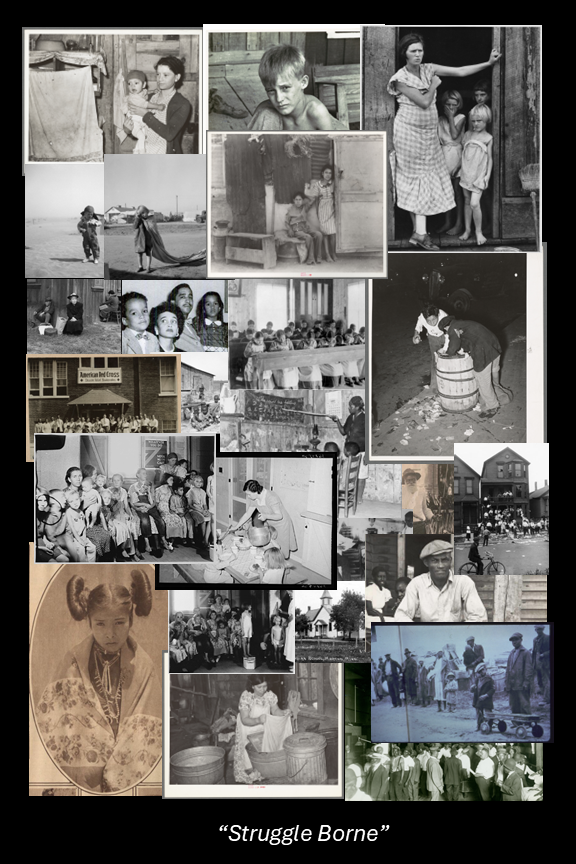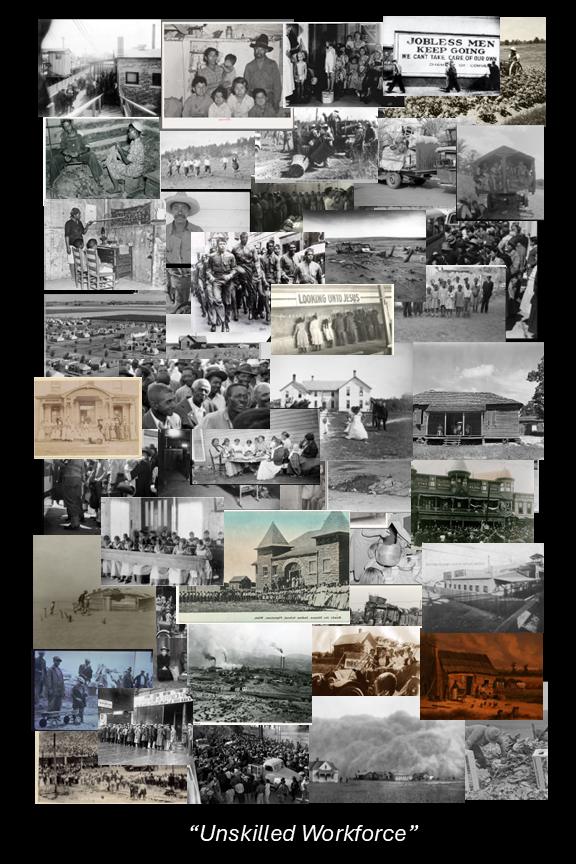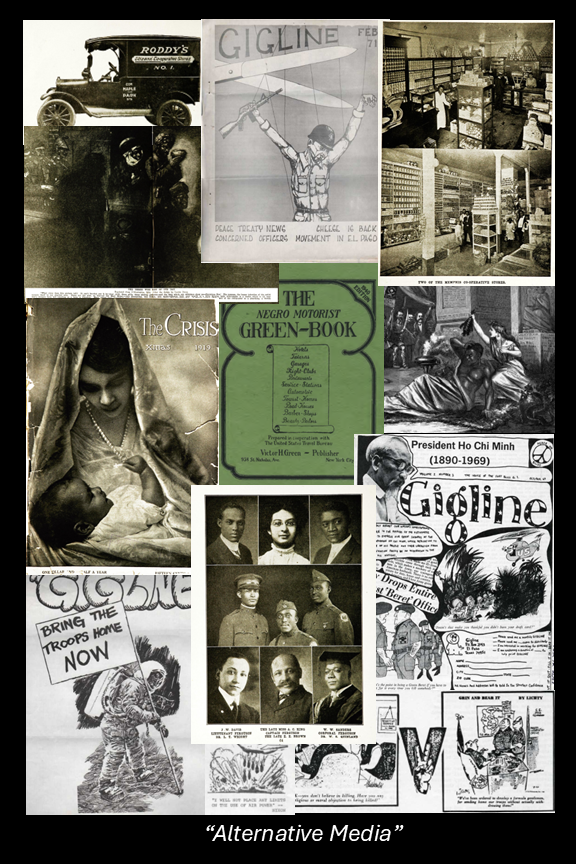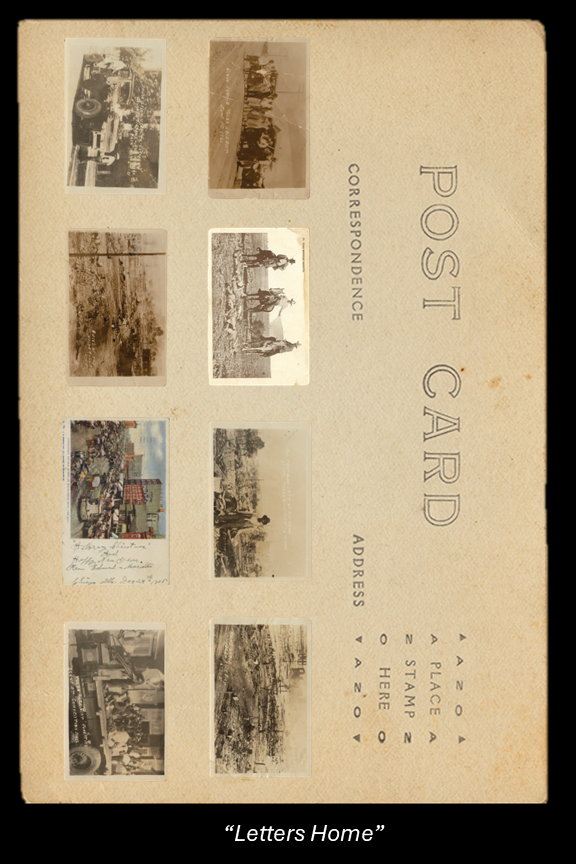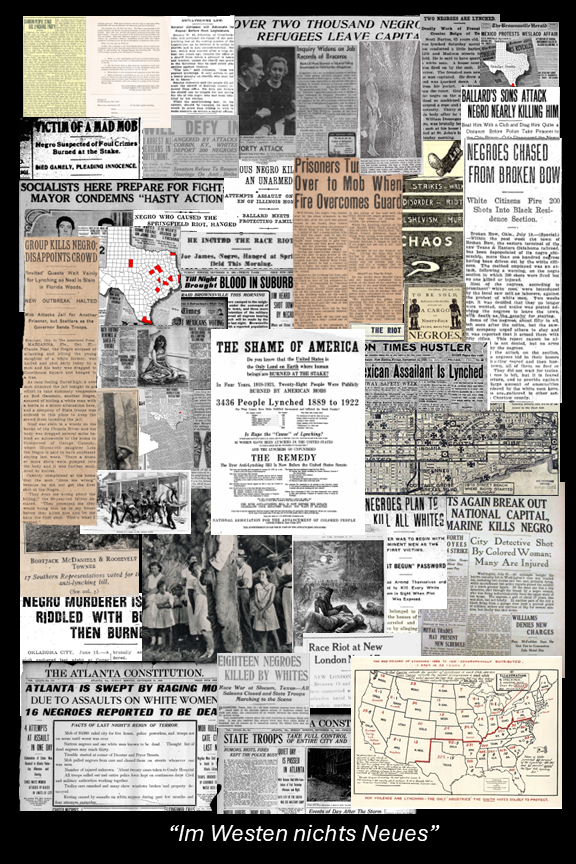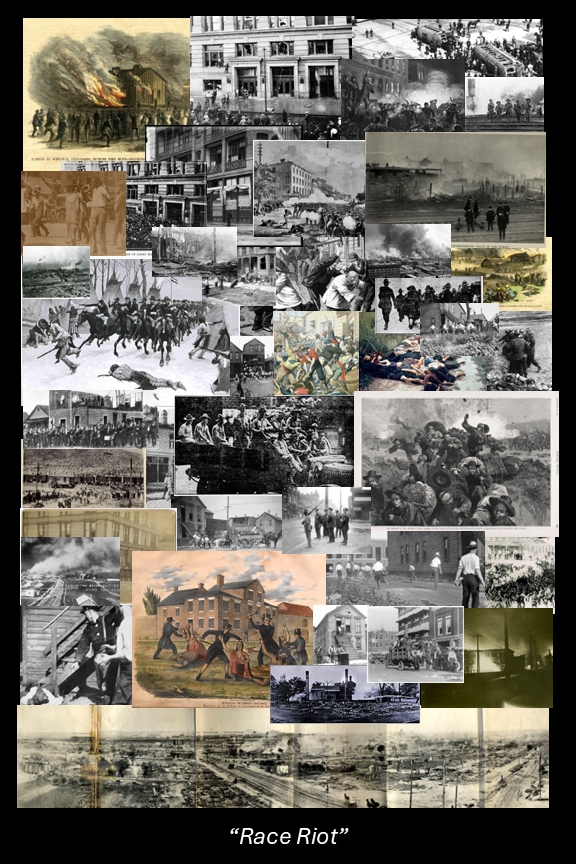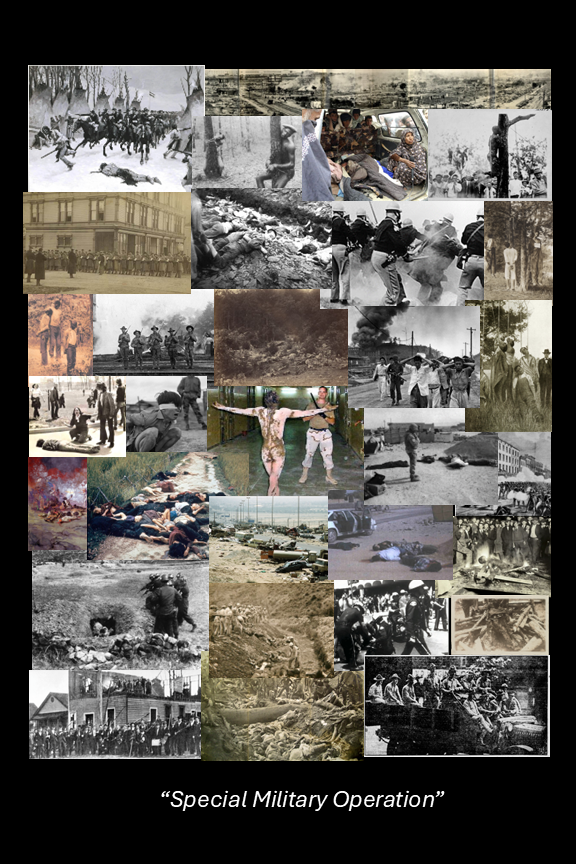An Appendix
“Star-Spangled Serpent”
“Struggle Borne”
This is a black and white photographic collage titled "Struggle Borne" containing approximately 20 historical photographs arranged in an overlapping layout. The images appear to document various aspects of hardship, poverty, and social struggle, likely from the early-to-mid 20th century.
The photographs include:
Scenes of domestic life showing families in modest living conditions
A young child sitting alone, appearing malnourished or distressed
Groups of people, including children, gathered in what appear to be institutional or communal settings
A woman in an apron standing in a doorway with children visible behind her
People engaged in manual labor or daily survival activities
Crowd scenes showing groups of people, possibly during economic hardship or social unrest
Images of simple housing structures and living conditions
A portrait of a woman in patterned clothing
Various scenes depicting the daily struggles of working-class or impoverished communities
The photographs have the documentary style characteristic of Depression-era photography or social realism, capturing both individual portraits and broader social conditions. The collage arrangement creates a narrative about perseverance through difficult circumstances, with the title "Struggle Borne" reinforcing themes of endurance and survival in the face of adversity. The overlapping presentation suggests interconnected experiences of hardship across different communities and time periods.
“Unskilled Workforce”
This is a black and white photographic collage titled "Unskilled Workforce" containing approximately 40-50 historical photographs arranged in an overlapping montage format. The images appear to document various aspects of labor, employment struggles, and working conditions, likely spanning from the early to mid-20th century.
The photographs include:
A prominent sign reading "JOBLESS MEN KEEP GOING WE CAN'T TAKE CARE OF OUR OWN"
Groups of men standing in unemployment lines or gathering for potential work
Railroad tracks and train-related scenes, suggesting migrant labor or transportation
Construction and manual labor scenes showing workers at various job sites
Crowds of people, likely job seekers or workers during economic hardship
Simple housing structures and work camps
Agricultural or farming scenes with workers in fields
Industrial settings and factory-related imagery
Bread lines or food distribution scenes
Workers with tools and equipment
Various outdoor labor activities including road work and construction
Scenes of workers loading trucks or engaged in manual tasks
Group photographs of laborers and work crews
The collage captures the experience of manual laborers, seasonal workers, and the unemployed during what appears to be the Great Depression era. The arrangement suggests themes of economic hardship, the search for work, and the struggles of those dependent on physical labor for survival. The title "Unskilled Workforce" reflects the classification and challenges faced by workers without specialized training during periods of economic uncertainty.
“Alternative Media”
This is a black and white collage titled "Alternative Media" featuring various historical publications, newspapers, and media materials that appear to represent counterculture, radical, or independent press from different eras.
The collage includes:
A vintage car with "RODDY'S" signage
"GIGLINE" publication with what appears to be a military or protest-related illustration
"The Crisis" publication, which appears to be associated with civil rights or social justice movements
"THE NEGRO MOTORIST GREEN-BOOK" - a historically significant travel guide for African American travelers during the Jim Crow era
Various portraits of what appear to be civil rights leaders, journalists, or activists arranged in formal group photographs
"GASOLINE" publication with protest imagery and text reading "BRING THE TROOPS HOME NOW"
References to President Ho Chi Minh (1890-1969), suggesting Vietnam War era materials
Various underground or alternative press publications and newsletters
Comic-style illustrations and political cartoons
Multiple small-format publications that appear to be zines, pamphlets, or independent newspapers
The materials span different time periods and movements, representing various forms of alternative journalism, activist publications, and independent media that provided perspectives outside mainstream press. The collection suggests themes of social justice, anti-war sentiment, civil rights, and grassroots communication during periods of social and political change in American history.
“Letters Home”
This is a historical collage titled "Letters Home" featuring eight vintage postcards documenting lynchings in the United States, arranged in a 4x2 grid on a cream-colored background designed to resemble a vintage postcard format.
The images show scenes of racial violence and lynching from the late 19th/early 20th century American South. These postcards were actual historical artifacts that documented and commemorated acts of racial terrorism, often featuring crowds of white spectators gathered around victims. Such postcards were commonly produced, sold, and mailed through the U.S. postal system during this period, representing the normalization and celebration of racial violence in American society.
The right side of the collage features "POST CARD" text in outlined letters, with "CORRESPONDENCE" and "ADDRESS" sections mimicking traditional postcard layout. A compass-like directional symbol appears at the bottom right.
The title "Letters Home" references how these disturbing images were literally sent as correspondence between family members and friends, documenting one of the most horrific chapters in American history. This collage serves as historical evidence of systemic racial violence and the commercialization of lynching through the postal system, representing crucial but deeply traumatic documentation of America's history of racial terrorism.
Such materials are typically preserved in historical archives and museums as important records for education, remembrance, and understanding the extent of institutionalized racial violence in American history.
“Im Westen nichts Neues”
This is a collage titled "Im Western nichts Neues" (German for "All Quiet on the Western Front") composed of historical newspaper clippings and headlines documenting racial violence and civil unrest in American history.
The collage features numerous newspaper headlines and articles including:
"OVER TWO THOUSAND NEGRO REFUGEES LEAVE CAPITA"
"NEGROES CHASED FROM BROKEN BOW"
"THE SHAME OF AMERICA"
"3436 People Lynched 1889 to 1922"
"NEGRO FAUKERER IS RIDDLED WITH BULLETS THEN BURNED"
"ATLANTA IS SWEPT BY RAGING MOB DUE TO ASSAULTS ON WHITE WOMEN 10 NEGROES REPORTED TO BE DEAD"
"GALLAGHER'S SOS ATTACK NEGRO NEARLY KILLING HIM"
Various other headlines about racial violence, lynchings, and mob attacks
The newspapers appear to span from the late 19th through mid-20th centuries, documenting systematic racial terrorism including lynchings, race riots, forced migrations, and mob violence against Black Americans. Some clippings include statistical information about lynching numbers and maps showing affected regions.
The German title creates an ironic juxtaposition, referencing the famous anti-war novel while presenting America's own internal racial warfare. This collage serves as historical documentation of the extensive newspaper coverage of racial violence, showing how such events were reported in mainstream media during periods of intense racial terrorism in American history.
The compilation demonstrates the widespread and systematic nature of racial violence that was extensively documented in contemporary press coverage.
“Race Riot”
This is a historical collage titled "Race Riot" containing approximately 40-50 photographs and illustrations documenting racial violence and civil unrest in American history, primarily from the late 19th through mid-20th centuries.
The images include:
Burning buildings and smoke-filled cityscapes from race riots
Destroyed and damaged commercial districts and neighborhoods
Armed groups and military/police forces deployed during racial conflicts
Crowds of people in streets during periods of unrest
Aftermath scenes showing rubble and destruction
Historical illustrations and paintings depicting racial violence
Buildings with broken windows and fire damage
People fleeing or gathered during riot situations
Military personnel and vehicles in urban settings
Aerial or wide shots of devastated city blocks
Both black and white photographs and some colorized historical artwork
The collage documents major race riots and massacres in American history, including events like the Tulsa Race Massacre, Red Summer riots, Detroit riots, and other instances of racial violence that destroyed Black communities and businesses. Many images show the systematic destruction of prosperous Black neighborhoods, often referred to as "Black Wall Streets."
This collection serves as visual documentation of the cyclical nature of racial violence in America, showing how racial tensions repeatedly erupted into organized destruction of Black communities, property, and lives. The compilation represents one of the darkest recurring themes in American social history - the violent suppression and destruction of Black economic and social progress.
“Special Military Operation”
This is a historical collage titled "Special Military Operation" containing approximately 30-40 photographs documenting various military conflicts, atrocities, and war crimes from different time periods and locations.
The images include:
Mass graves and excavation sites revealing human remains
Bodies of victims in various states of decomposition
Military personnel and soldiers in combat gear
Scenes of destruction including bombed buildings and rubble
What appears to be execution scenes and aftermath of massacres
Winter warfare scenes with soldiers in snow
Prisoners or detainees in various situations
Urban warfare and destroyed cityscapes
Military vehicles and equipment
Scenes that appear to document war crimes and genocide
Both historical black and white photographs and more recent color images
Documentation that spans multiple conflicts and time periods
The title "Special Military Operation" appears to be a reference to euphemistic language used to describe military actions while minimizing their true nature. The collage presents stark visual evidence of the brutal realities of warfare, genocide, and military violence across different conflicts.
This compilation serves as documentation of the human cost of war and military operations, showing the gap between sanitized official language and the actual violence and atrocities committed during armed conflicts. The images represent some of the darkest moments in human history where military power was used against civilian populations.







